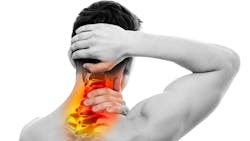Pain from dental hygiene: A nuisance, distressing, or debilitating?
Editor's note: This is part one of a two-part series. Read part two.
We are all familiar with what often happens when a dental patient calls the office with a complaint of pain, right? Routinely, the patient is immediately added to the dentist’s schedule for therapeutic treatment. Most dental professionals would agree that this is not the time for preventive procedures, such as a fluoride application or a change in toothbrush technique.
As dental professionals, why do we treat ourselves with less regard for our own health and career longevity? It is now well documented that dental careers are subject to the possibility of many musculoskeletal disorders (MSDs), defined as an injury of the muscles, ligaments, nerves, cartilage, bones, or blood vessels in the arms, legs, neck, or back. The pain of an MSD for a dental professional is no less debilitating than that of our dental patients’ pain. Attention to its diagnosis and treatment needs to be just as immediate.
Additional reading:
- Establishing the ideal posture for your practice: Let's put it in neutral
- Common ergonomic errors and solutions for dental hygienists
- Get the upper hand: Ergonomic strategies to avoid musculoskeletal injuries
Signs versus symptoms
Let’s take some of the diagnostic concepts that we were taught in school and apply them to our own health. A sign is any abnormality indicative of disease, discoverable on examination of a patient; it is an objective indication of disease, in contrast to a symptom that is a subjective indication of disease.1 A symptom is any morbid departure from normal in structure or function experienced by the patient and indicative of disease.2 A sign is verifiable. It is the definite indication of the occurrence of a specific disease. A symptom, on the other hand, is a vague report by a patient; something the patient feels or experiences. Pain is the most common symptom of injury and disease, and descriptions can range in intensity from a mere ache to unbearable agony.3 Signs of an injury are present long before symptoms, such as pain, occur.
Musculoskeletal pain
Musculoskeletal pain can affect bones, joints, ligaments, muscles, tendons, bursas, or any combination, though injury is the most common cause.4,5 The pain can be acute, meaning it is sudden and severe, or it can be chronic (long-lasting). It can be localized pain (in one area of the body) or it may affect the entire body.4 Symptoms of musculoskeletal pain include aching and stiffness, burning sensations in the muscles, fatigue, muscle twitches, pain that worsens with movement, and sleep disturbances.4 In addition, it can include weakness, joint noises, inflammation, and decreased range of motion.5
Tests used in diagnosis of musculoskeletal pain can begin with x-rays and rheumatoid factor and antinuclear antibody blood tests, used to help diagnose common causes of arthritis. Further testing can include magnetic resonance imaging (MRI) for the identification of abnormalities of soft tissues or a computed tomography (CT) scan to obtain more detail about a bone problem.5
Pain management of milder MSD pain can be relieved with over-the-counter medications, such as NSAIDs or acetaminophen; hot and cold therapies; strengthening, conditioning, and stretch exercises; and stress-reduction techniques.4 Treatment of an MSD will be more specific depending upon the underlying cause, but common treatments include pain relievers, acupuncture, chiropractic adjustment, occupational therapy, physical therapy, splints, steroid injections, and therapeutic massage.4,5
Neuropathic pain
Pain can be deceptive. Its source is not always the location where it is manifested. Damaged nerve fibers can send incorrect signals to other pain centers within the body.6,7 Neuropathic pain is defined by the International Association for the Study of Pain (IASP) as “pain initiated or caused by a primary lesion or dysfunction of the nervous system.”8 Neuropathic pain is due to nerve compression or entrapment neuropathies, such as ruptured disk or carpal tunnel syndrome, nerve damage due to a chronic and progressive disease, or an injury resulting in the abnormal or disrupted processing of pain signals by the brain or spinal cord.9,10 Neuropathic pain may be constant or intermittent. It does not usually begin suddenly nor is it alleviated instantly. Symptoms of neuropathic pain are a persistent numbness or a loss of sensation, shooting, stabbing, burning, or tingling, and may be deep and aching. It may result in an inability to sleep or rest.6,7,9,10
Identification of the source of neuropathic pain can be challenging because it is based upon the patient’s subjective words and descriptions. Most often, a visual analog scale (VAS) is used throughout the process of treatment and as a comparison during recovery (figure 1).10 The most accepted diagnostic tool to evaluate neuropathic pain is a nerve conduction study with electromyography (EMG). The purpose of an EMG is to determine any loss of function using touch, temperature, and vibration.9 Additional imaging studies and blood work may be needed.
Common medicinal treatments range from nonsteroidal anti-inflammatory drugs, to a lidocaine patch, to tricyclic antidepressants (e.g., amitriptyline, nortriptyline, or desipramine), to selective serotonin reuptake inhibitors (e.g., paroxetine and citalopram), to antiseizure medications (e.g., carbamazepine, phenytoin, gabapentin, or lamotrigine).6-10 Additional treatments include acupuncture, epidural or perineural nerve blocks, electrical impulse-emitting implant devices, and lifestyle treatments such as relaxation and massage therapy.
Many of the tasks dental professionals are required to perform can result in the development of musculoskeletal disorders or injury to the central nervous system. Long-term, chronic pain can negatively affect the ability to maintain an enjoyable workplace environment and a high-quality lifestyle.
Editor's note: This article appeared in the May 2022 print edition of RDH magazine. Dental hygienists in North America are eligible for a complimentary print subscription. Sign up here.
References
- Definition of “sign.” Medical Dictionary of the Free Dictionary. Accessed January 5, 2022. https://medical-dictionary.thefreedictionary.com/sign
- Definition of “symptom.” Medical Dictionary of the Free Dictionary. Accessed January 5, 2022. https://medical-dictionary.thefreedictionary.com/symptom
- Definition of “pain.” Medical Dictionary of the Free Dictionary. Accessed January 5, 2022. https://medical-dictionary.thefreedictionary.com/pain
- Musculoskeletal pain. Cleveland Clinic. Accessed January 7, 2022. https://my.clevelandclinic.org/health/diseases/14526-musculoskeletal-pain
- Villa-Forte A. Musculoskeletal pain. Merck Manual Consumer Version. Updated February 2021. Accessed January 7, 2022. https://www.merckmanuals.com/home/bone,-joint,-and-muscle-disorders/symptoms-of-musculoskeletal-disorders/musculoskeletal-pain
- Neuropathic pain. Cleveland Clinic. Accessed January 7, 2022. https://my.clevelandclinic.org/health/diseases/15833-neuropathic-pain
- Holland K. What you should know about neuropathic pain. Healthline. February 5, 2020. Accessed January 28, 2022. https://www.healthline.com/health/neuropathic-pain
- Svokos K, Goldstein L. The pathophysiology of neuropathic pain. Pract Pain Manag. Updated December 29, 2011. Accessed January 19, 2022. https://www.practicalpainmanagement.com/pain/neuropathic/pathophysiology-neuropathic-pain
- Watson JC. Neuropathic pain. Merck Manual Consumer Version. Updated April 2020. Accessed January 7, 2022. https://www.merckmanuals.com/home/brain,-spinal-cord,-and-nerve-disorders/pain/neuropathic-pain
- MedicineNet. Neuropathic pain (nerve pain). Treatment, types, definition, and medication. MedicineNet. Updated December 11, 2020. https://www.medicinenet.com/neuropathic_pain_nerve_pain/article.htm
About the Author

Cindy M. Purdy, BSDH, RDH, CEAS
Cindy M. Purdy, BSDH, RDH, CEAS, has a passion for workplace wellness that has resulted in the creation of THRIVE, a dental-oriented wellness and therapeutic alternatives summit for dental professionals. THRIVE occurs three to four times annually at Glen Eyrie Castle in Colorado Springs, Colorado. Attendance information can be found at cindypurdy.com. In addition to multiple decades as a clinical dental hygienist, Cindy holds an ergonomic certification from Colorado State University, a certified ergonomic assessment specialist credential, and is certified in health-care ergonomics.

